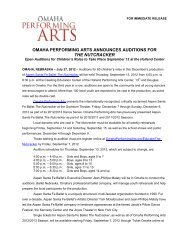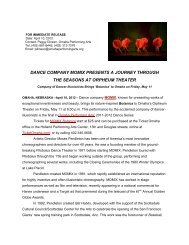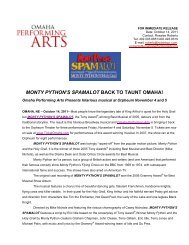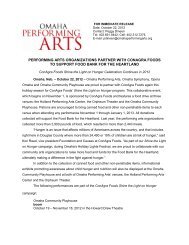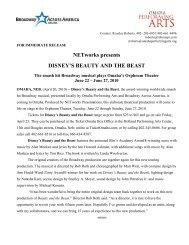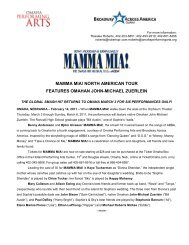Yamato Study Guide - Omaha Performing Arts
Yamato Study Guide - Omaha Performing Arts
Yamato Study Guide - Omaha Performing Arts
You also want an ePaper? Increase the reach of your titles
YUMPU automatically turns print PDFs into web optimized ePapers that Google loves.
YAMATODRUMMERS OF JAPAN<strong>Study</strong> <strong>Guide</strong>2011-2012 Student Matinee Series
Contents of <strong>Study</strong> <strong>Guide</strong>:• About <strong>Yamato</strong> Drummers of Japan• Taiko in Performance• Types of Taiko Drums• Other Instruments Used in Taiko• ResourcesAbout <strong>Yamato</strong> Drummers of JapanJapanese Taiko drummers “<strong>Yamato</strong>” formed in <strong>Yamato</strong>-nokuni(country of <strong>Yamato</strong>), the present-day Nara prefecture,in 1993 by Masa Ogawa. <strong>Yamato</strong> is headquartered in thevillage of Asuka in Nara, which is known for its ancientmonuments and named as the birthplace of Japanese culture. For its first performance, <strong>Yamato</strong> parcipated in a fesval held atthe Toichi shrine in Kashihara-shi, Nara, playing a piece called “Hyuga.” What started as just a one-me performance, <strong>Yamato</strong> nowperforms more than 200 mes a year worldwide. Growing from just four members to seventeen members now, the group consistsof men and women and is divided into two secons. In addion to concerts, <strong>Yamato</strong> works on many acvies involving schools andteaching.Life of a Drummer<strong>Yamato</strong> Drummers of Japan live in the village of Asuka , which is more than a thousand years old. The average day of a drummerstarts with a 10 km run followed by weight training . Then, in the aernoon, the drummers have group pracce and the eveningsare filled with individual pracce. The group generally travels six to 10 months out of the year. In all, <strong>Yamato</strong> Drummers of Japanhave presented 2,300 performances in 51 countries around the world. Their moo is: “Go anywhere we’re invited and make theworld happier.”For more informaon, visit www.<strong>Yamato</strong>.jp
Taiko in PerformanceTaiko music recalls the very origins of music in the movement of the body and should be seen as well as heard. Taiko performanceis based on the modulaon between the “female” (le hand) and the “male” (right hand) strokes of the drumscks—the femalestroke is always so and the male is always a strong stroke. The modulaon between so and strong is the primary component oftaiko drumming. In performance, cymbals, gongs, flutes, koto (Japanese zither) and shamisen (Japanese lute) augment the percussion.The rhythms the drummers use are somemes intense, somemes funny and warm, expressing different moods, mes andplaces. The musicians seek to link their hearts and souls with the beang of the drums. <strong>Yamato</strong> Drummers of Japan founder MasakiOgawa explains: “We are a group of people who create the beat of life by using a simple and interesng instrument and insllingour souls into it.”Pre-Performance Acvity:As a class project, have students research and report on Japan—its history and culture. As part of the project,have students bring in items from or pertaining to Japan (magazine arcles, pictures, movies, toys, clothes, etc.).Use them to create a classroom display. Discuss what you might take to Japan to represent our culture.
A Brief History of TaikoTaiko, the Japanese word for drum and the name of the art form, has its roots in ancient Japanese tradion. For hundreds, maybeeven thousands of years, the taiko was used in religious ceremonies, community fesvals and theater. Drums were also used toscare birds away from crops and to urge soldiers forward in bale.It’s said that the boundaries of villages were defined by the distance from which the community odaiko (large drum) could beheard. So, in most cases, the louder the taiko, the bigger the village. In fact, some drums were huge—10 to 15 feet in diameter—and pounded upon with drumscks as big as baseball bats!Over me, the drums became symbols of unity and celebraon. Later, the taiko evolved into an important solo instrument in itsown right. Taiko today is not just drumming but also part dance and something that looks like maral arts. In some pieces, thedrummers shi quickly from one drum to another, all moving as one. Taiko drummers train like maral arsts so that they canstrike the drum not just with their arms but with their whole bodies.Pre-Performance Acvity:Locate and play recordings of Japanese tradional music, taiko drumming in parcular, in class. Discuss thedifferences in mood, rhythm and feeling. Ask students to compare and contrast this music with Americantradional and contemporary music.Types of Taiko DrumsByou-daikoByou-daiko (also called byou uchi-daiko) have bodies that are tradionally carved from a single log and heads that are stretchedonto the taiko and tacked in place. This style of taiko cannot be tuned aer the head is stretched. The nagado-daiko is the mostrepresentave style of byou-daiko. It seems very likely that this style of taiko has its roots in Chinese or Korean antecedents.The favored wood for byou-daiko is keyaki (Japanese elm), which possesses all the qualies a taiko maker looks for: hardness;good tone; and a beauful grain paern. Since the bodies of byou-daiko are carved from a single log, making a large taiko typicallyrequires a large tree that has grown for a minimum of two hundred years; the largest odaiko ever produced required a treethat was 1,200 years old. However, with proper care, a body can last for hundreds of years.The heads are made from cowhide, and it is said that three to four year old black Japanese cows produce the best hides. Properpreparaons of the hide and the process to stretch the heads are typically considered trade secrets and are guarded carefully.Very large odaiko requires the full hide from a Holstein bull.Nagado-daikoThe nagado-daiko is by far the most popular taiko used in the modern kumi-daiko style of playing. They arealso very common in fesvals and in temples and shrines. They have a characteriscally deep, reverberantsound. There are many styles of playing this taiko, with a wonderful selecon of different stands that holdthe nagado-daiko in various posions.
OdaikoOdaiko literally means "big fat drum" and can refer to any large taiko drum. However, the termis usually reserved for nagado-daiko that have a head over three feet in diameter. Odaiko aretypically placed on a stand and played horizontally, oen by two people at once. Typically, oneplayer will beat out a basic rhythm while the second player solos.Odaiko can reach huge proporons, somemes weighing in at over three tons and spanning sixfeet in diameter. These mammoth Odaiko are oen built for shrines or temples, and their costcan run into the hundreds of thousands of dollars.Hira-daikoThe hira-daiko tends to be a small drum, but they can reach extremely large proporons as well. The bigversions are popular among many taiko groups who can buy an odaiko sized hira-daiko for much less thanan equivalent nagado-daiko. Smaller hira-daiko are not used much in kumi-daiko but have a place as anorchestral instrument in Hayashi music. They have a boom-like, reverberant sound like the nagado-daiko,but it decays much faster due to the shallow body.Shime-daikoShime-daiko is a general term for a rope-tensioned drum. The word "shime" comes from the Japaneseverb "shimeru", which means to bind or ghten up. It seems likely that the shime-daiko is a naveJapanese invenon, unlike the byou-daiko. Shime-daiko have two heads which are sewn over steelrings and laced to a body with a rope or cord. They are tensioned with another rope or cord that iswound around the lacings of the first rope. The pitch can be changed by adjusng the ghtness of thissecond rope.Used specifically, the term shime-daiko means a small drum used in Japanese classical music. It has a one piece body carved outof a hardwood, typically keyaki. The body is oen beaufully lacquered and decorated. Heavier, undecorated versions for folkmusic are used by almost every taiko group. This heavier version is properly called a tsukeshime-daiko, but most people just call ita shime. The tsukeshime daiko has a thicker, stronger body and uses much thicker leather for the heads than a classical shime.This allows the tsukeshime to be tensioned to remarkably high pitches.Using the term broadly, shime-daiko can range in size from the small, hand held kotsuzumi to tanic okedo style drums over tenfeet in diameter. Small shime tend to have bodies carved from a single piece of wood similar to byou-daiko. Larger shime such asoke-daiko have lightweight bodies made from staves of a sowood, such as Hinoki (Japanese cypress).Oke-daikoThe oke-daiko, or okedo, is made with a stave construcon, not carved from a single piece of wood as isthe case with the nagado-daiko. They tend to be larger than a typical nagado-daiko, oen around six feetin length and three feet in diameter. They are usually played horizontally, raised up on a high stand. Thereare also short bodied styles which are becoming increasingly popular. They have a loud, flat, boomingsound and are oen played with slats of bamboo, which produces a sharp, slapping sound.hp://www.taikomasa.co.jp/english/index.php
Other Instruments Used in TaikoBiwa. A three-stringed lute with four frets and a disncve rounded back. It is played with a large pick or "bachi."Hyooshigi: Wooden clappers.Kagura suzu: A hand-held bell tree with three ers of pellet bells.Ita-sasara: A rale constructed of several wooden slats anchored to the instrument’s mainsha by cords. When repeatedly flicked by its two handles, the slats strike each other making adisncve rasping sound.Kane: A gong used to keep musical beat. Either hand-held or hung by a cord, it is struck with amallet.Koto: A stringed instrument resembling the zither. It usually has thirteen strings.Shakuhachi: This tradional bamboo flute is oen used by the Shumei Taiko Ensemble during performances, and the refined sonicbalance between drums and flutes is a signature of the Ensemble's performance style. Shakuhachi come in a variety of sizes andhave four holes at their front and one at their back. Their evocave sound is delicately nuanced and breathy.Shamisen: One of a number of Japanese stringed instruments that resembles thebanjo. It has three strings and is played with a pick or "Bachi."Yotsutake: Bamboo clappers.Post-Performance Acvity:Using what they’ve learned about the tradion of taiko, have students write areview of YAMATO DRUMMERS OF JAPAN’s performance.




